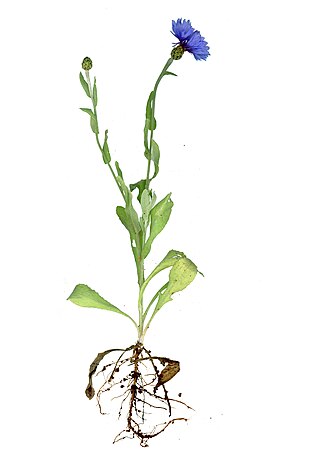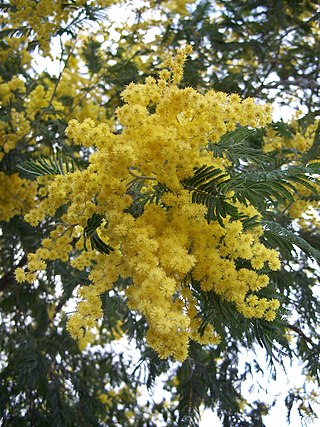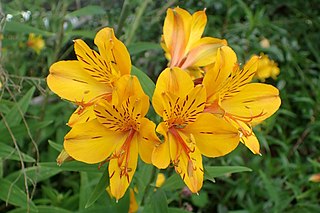
Centaurea is a genus of over 700 species of herbaceous thistle-like flowering plants in the family Asteraceae. Members of the genus are found only north of the equator, mostly in the Eastern Hemisphere; the Middle East and surrounding regions are particularly species-rich.

Centaurea cyanus, commonly known as cornflower or bachelor's button, is an annual flowering plant in the family Asteraceae native to Europe. In the past, it often grew as a weed in cornfields, hence its name. It is now endangered in its native habitat by agricultural intensification, particularly by over-use of herbicides. However, Centaurea cyanus is now also naturalised in many other parts of the world, including North America and parts of Australia through introduction as an ornamental plant in gardens and as a seed contaminant in crop seeds.

Geranium sanguineum, common names bloody crane's-bill or bloody geranium, is a species of hardy flowering herbaceous perennial plant in the cranesbill family Geraniaceae. It is the county flower of Northumberland.

Campanula glomerata, known by the common names clustered bellflower or Dane's blood, is a species of flowering plant in the genus Campanula, belonging to the family Campanulaceae. It is the county flower of Rutland, England.

Jacobaea maritima, commonly known as silver ragwort, is a perennial plant species in the genus Jacobaea in the family Asteraceae, native to the Mediterranean region. It was formerly placed in the genus Senecio, and is still widely referred to as Senecio cineraria; see the list of synonyms (right) for other names.

Vinca major, with the common names bigleaf periwinkle, large periwinkle, greater periwinkle and blue periwinkle, is a species of flowering plant in the family Apocynaceae, native to the western Mediterranean. Growing to 25 cm (10 in) tall and spreading indefinitely, it is an evergreen perennial, frequently used in cultivation as groundcover.

Centaurea cineraria, the velvet centaurea, also known as dusty miller and silver dust, is a species of flowering plant in the family Asteraceae endemic to southern Italy. In natural settings, it grows on coastal cliffs, ranging from 0–350 m above sea level, hence the plant's Italian name, fiordaliso delle scogliere. Mature plants may reach 80 centimetres (31.5 in) in height. The species produces purple flowers.

Acacia dealbata, the silver wattle, blue wattle or mimosa, is a species of flowering plant in the legume family Fabaceae, native to southeastern Australia in New South Wales, Victoria, Tasmania, and the Australian Capital Territory, and widely introduced in Mediterranean, warm temperate, and highland tropical landscapes.

Phlox subulata the creeping phlox, moss phlox, moss pink or mountain phlox, is a species of flowering plant in the family Polemoniaceae, native to eastern and central USA, and widely cultivated.

Fritillaria persica is a Middle Eastern species of flowering plant in the lily family Liliaceae, native to southern Turkey, Iran, Iraq, Lebanon, Syria, Cyprus and Israel. It is widely cultivated as an ornamental and naturalized in the Lazio region of Italy. It is the sole species in Fritillaria subgenus Theresia.

Geranium psilostemon, commonly called Armenian cranesbill, is a species of hardy flowering herbaceous perennial plant in the genus Geranium, family Geraniaceae. It is native to Turkey, Armenia, Azerbaijan, and the Russian Federation. Forming a large clump to 120 cm (47 in) tall, it has glowing reddish purple colored flowers with prominent dark centres, and divided leaves tinted red in Autumn. It is cultivated as a garden subject, and a number of different cultivars exist. G. psilostemon has the UK’s hardiest rating, surviving temperatures as low as −20 °C (−4 °F).

Scilla bifolia, the alpine squill or two-leaf squill, is a herbaceous perennial plant growing from an underground bulb, belonging to the genus Scilla of the family Asparagaceae.

Campanula punctata, the spotted bellflower, is a species of flowering plant in the bellflower family Campanulaceae. This ornamental herbaceous perennial is native to Japan, Korea, China and Siberia, and is widely cultivated for its attractive bell-shaped flowers.

Phormium is a genus of two plant species in the family Asphodelaceae. One species is endemic to New Zealand and the other is native to New Zealand and Norfolk Island. The two species are widely known in New Zealand as flax or their Māori names wharariki and harakeke respectively, and elsewhere as New Zealand flax or flax lily, but they are not closely related to the Northern Hemisphere's flax, which is native to the region extending from the eastern Mediterranean to India and has been used by humans since 30,000 B.C.

Artemisia schmidtiana, common name silvermound, is a species of flowering plant in the family Asteraceae, native to Japan but widely cultivated as an ornamental.

Crocus speciosus, with common name Bieberstein's crocus, is a species of flowering plant in the genus Crocus of the family Iridaceae. The plant is native to northern and central Turkey, the Caucasus, northern Iran, Crimea and Bulgaria.

Nepeta racemosa, the dwarf catnip or raceme catnip, syn. N. mussiniii, is a species of flowering plant in the mint family Lamiaceae, native to the Caucasus, Turkey and northern Iran. Growing to 30 cm (12 in) tall by 45 cm (18 in) wide, it is a herbaceous perennial with aromatic leaves and violet or lilac-blue flowers in summer.

Betonica macrantha, formerly Stachys macrantha, known as big betony, is a species of flowering plant in the mint family Lamiaceae. It is native to the Caucasus, northeastern Turkey, and northwestern Iran. Growing to 60 cm (24 in) tall by 30 cm (12 in) broad, it is an erect herbaceous perennial with scalloped cordate leaves. Spikes of hooded purplish-pink flowers are borne throughout summer.
Cornflower is a flowering annual plant Centaurea cyanus.

Alstroemeria aurea is a species of flowering plant in the family Alstroemeriaceae, native to Chile and Argentina, but naturalised in Australia, New Zealand and the United Kingdom. It is also widely cultivated as an ornamental.



















